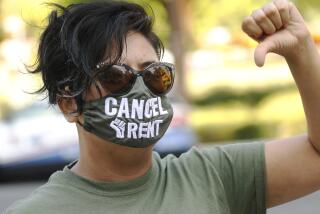Judge Says Lawndale Can’t Use Loitering Law Against Day Workers : Government: Officials are now relying on an ordinance that prohibits seeking or offering jobs along city streets.
- Share via
An anti-loitering ordinance that was used to keep day laborers off the streets of Lawndale was overturned by a municipal judge last week, but city officials said the decision will not affect the city because it is using a different law to control curbside job seekers.
Niels Frenzen, one of three attorneys who challenged the anti-loitering ordinance, said the law was being used to target Latinos and led to citations for some men who were performing legitimate errands.
South Bay Municipal Judge Deanne Smith Myers ruled that the ordinance was too vague and allowed police to arrest people who were merely talking on the sidewalk and inadvertently blocking the paths of others.
But Lawndale officials, noting complaints that some of the workers have disrupted businesses and harassed homeowners, said they will continue to enforce a new ordinance that prohibits seeking or offering jobs along city streets.
“Lawndale is 1.9 square miles,” Councilman Larry Rudolph said Tuesday. “We have no empty land anywhere. I just don’t understand why we should take the whole burden of the South Bay on our shoulders. . . . They’re not really working in Lawndale. They’re just using our streets to solicit work elsewhere.”
Dozens of men began seeking jobs on the streets of Lawndale two years ago, after neighboring Redondo Beach passed an ordinance prohibiting the solicitation of work from the streets, Lawndale City Atty. David Aleshire said. City officials say many of the men are undocumented immigrants from Mexico and Central America who work for less than the minimum wage.
Residents began complaining that some of the 60 or more day workers who were lining up each morning along Inglewood Avenue between Artesia Boulevard and 164th Street were whistling at women, blocking sidewalks and urinating on front lawns.
One day last fall, Rudolph said, he drove up to a fast food restaurant on Artesia Boulevard “and two of them jumped into the back of my pickup truck.”
But it wasn’t until council members received copies of a petition in December, alleging that a day laborer had tried to sexually assault a 16-year-old girl, that city officials decided to take action against the problem.
“I like to walk and these people--there were too many of them on every corner,” said Lawndale homeowner Diane Buth, who gathered about 20 signatures for the petition. “Everyone who signed it was anxious to get them off the street.”
City officials dusted off an old anti-loitering ordinance and began citing day workers, said Bart Swanson, director of community safety. During the first 30 days, the officers had cited about 50 men for loitering, a misdemeanor charge that carries a fine of up to $1,000 and up to six months in jail.
Among those cited were Julio Cesar Chavarria and Roberto Paul Chavarria, both of Los Angeles, who claimed that they were on their way to buy painting supplies at a Sinclair Paint store--a popular spot for day laborers looking for construction work--when a sheriff’s deputy stopped them.
“(The officer) told us to keep quiet, that we had no right to talk,” Julio Chavarria, 33, said in an interview Tuesday. “(He) told us that he didn’t want to see us there anymore and that if he did, we were going to be put in jail.”
Frenzen, an attorney with Public Counsel, the nonprofit, public interest law office for the Los Angeles County and Beverly Hills Bar associations, agreed to represent the Chavarria brothers and Guadalupe Aboites, who was arrested for loitering on the same day.
Frenzen filed a request to have the charges against the three men dropped. He argued that the ordinance was unconstitutional because it was too vague and broad to be enforceable. Later, two attorneys representing four other men charged with loitering joined in the lawsuit.
In asking Myers to dismiss loitering charges, Frenzen listed more than 20 cases of similarly worded anti-loitering ordinances that had been deemed unconstitutional over the last two decades.
The wording of the Lawndale ordinance is “virtually identical to a statute struck down in Birmingham, Ala., that was used to prosecute black Americans engaged in economic boycotts undertaken during the civil rights movement in the 1960s,” Frenzen argued.
He noted that deputies and community safety officers were using the Lawndale ordinance specifically to target day workers. “I would wager that every one of the men (cited under the anti-loitering law) have brown skin,” Frenzen added, “because this doesn’t happen to white people.”
Myers dismissed the charges against all seven men and struck down the ordinance. Frenzen said he will try to identify all of those convicted under the law and will seek to have their records cleared.
“It feels good to know your rights are respected,” Julio Chavarria, 33, said Tuesday. “When something like that happens, you feel bad, like you’re not worth anything. No one likes to be treated that way.”
Deputy Dist. Atty. David Coffey, who prosecuted the men, said Wednesday that no decision has been made whether to appeal the judge’s ruling.
The ruling did not surprise Swanson, a former police officer, who said he recognized after about a month that the ordinance was probably unenforceable. In March, he directed the city’s community safety officers to stop citing day laborers for loitering and instead to use a newly adopted ordinance that prohibits people from seeking or offering employment on city streets.
Under procedures he developed, people who appear to be soliciting work are identified, their pictures are taken and they are warned that they are in violation of a city ordinance, Swanson said. After three warnings, a citation is issued. So far, only one suspected day laborer and four potential employers have been cited, he said.
Councilwoman Carol Norman, who was the lone dissenter in the vote on the new ordinance, said, “Basically, we’re shoving these men from city to city as we start to enforce these laws, which is pretty much how cities have been dealing with homelessness.”
She proposed that the city follow the lead of Encinitas in San Diego County, which recently set up a hiring hall for day laborers. But that idea won little support from her colleagues, who noted that many of the men seeking work on Lawndale’s streets end up working elsewhere.
The city also explored the possibility of setting up hiring halls on the grounds of neighborhood churches or private organizations, but those ideas died for lack of public support.
More to Read
Sign up for Essential California
The most important California stories and recommendations in your inbox every morning.
You may occasionally receive promotional content from the Los Angeles Times.










